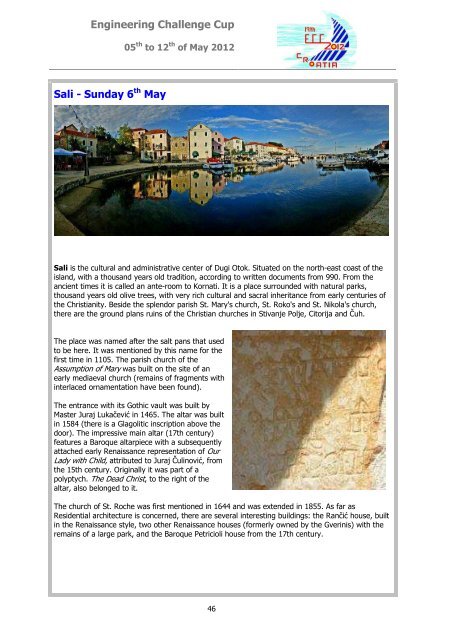ecc 2012 logbook - ECC 2013
ecc 2012 logbook - ECC 2013
ecc 2012 logbook - ECC 2013
- TAGS
- logbook
- ecc-sailing.com
You also want an ePaper? Increase the reach of your titles
YUMPU automatically turns print PDFs into web optimized ePapers that Google loves.
Engineering Challenge Cup<br />
Sali - Sunday 6 th May<br />
05 th to 12 th of May <strong>2012</strong><br />
Sali is the cultural and administrative center of Dugi Otok. Situated on the north-east coast of the<br />
island, with a thousand years old tradition, according to written documents from 990. From the<br />
ancient times it is called an ante-room to Kornati. It is a place surrounded with natural parks,<br />
thousand years old olive trees, with very rich cultural and sacral inheritance from early centuries of<br />
the Christianity. Beside the splendor parish St. Mary's church, St. Roko's and St. Nikola's church,<br />
there are the ground plans ruins of the Christian churches in Stivanje Polje, Citorija and Čuh.<br />
The place was named after the salt pans that used<br />
to be here. It was mentioned by this name for the<br />
first time in 1105. The parish church of the<br />
Assumption of Mary was built on the site of an<br />
early mediaeval church (remains of fragments with<br />
interlaced ornamentation have been found).<br />
The entrance with its Gothic vault was built by<br />
Master Juraj Lukačević in 1465. The altar was built<br />
in 1584 (there is a Glagolitic inscription above the<br />
door). The impressive main altar (17th century)<br />
features a Baroque altarpiece with a subsequently<br />
attached early Renaissance representation of Our<br />
Lady with Child, attributed to Juraj Čulinović, from<br />
the 15th century. Originally it was part of a<br />
polyptych. The Dead Christ, to the right of the<br />
altar, also belonged to it.<br />
The church of St. Roche was first mentioned in 1644 and was extended in 1855. As far as<br />
Residential architecture is concerned, there are several interesting buildings: the Rančić house, built<br />
in the Renaissance style, two other Renaissance houses (formerly owned by the Gverinis) with the<br />
remains of a large park, and the Baroque Petricioli house from the 17th century.<br />
46


